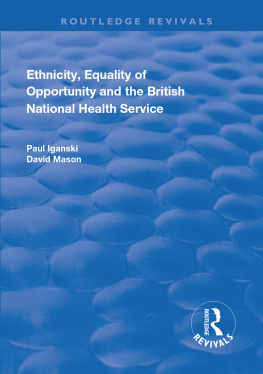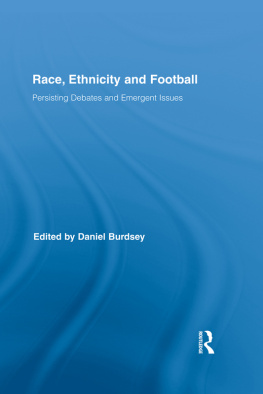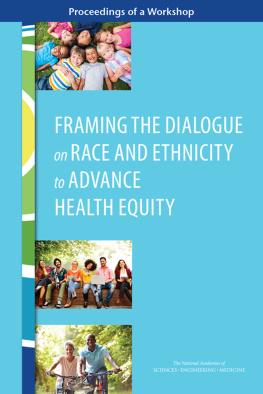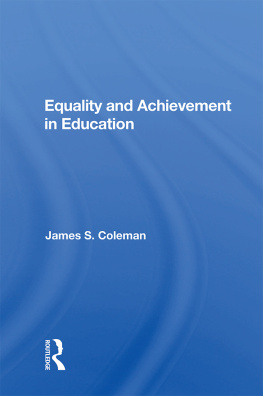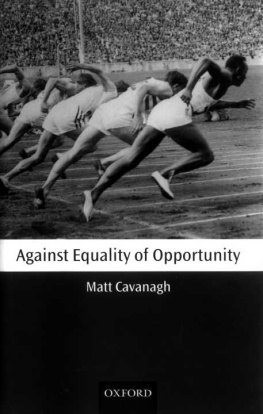First published 2002 by Ashgate Publishing
Reissued 2018 by Routledge
2 Park Square, Milton Park, Abingdon, Oxon OX14 4RN
711 Third Avenue, New York, NY 10017, USA
Routledge is an imprint of the Taylor & Francis Group, an informa business
Copyright Paul Iganski and David Mason 2002
All rights reserved. No part of this book may be reprinted or reproduced or utilised in any form or by any electronic, mechanical, or other means, now known or hereafter invented, including photocopying and recording, or in any information storage or retrieval system, without permission in writing from the publishers.
Notice:
Product or corporate names may be trademarks or registered trademarks, and are used only for identification and explanation without intent to infringe.
Publishers Note
The publisher has gone to great lengths to ensure the quality of this reprint but points out that some imperfections in the original copies may be apparent.
Disclaimer
The publisher has made every effort to trace copyright holders and welcomes correspondence from those they have been unable to contact.
A Library of Congress record exists under LC control number: 2001098005
ISBN 13: 978-1-138-72873-8 (hbk)
ISBN 13: 978-1-315-19039-6 (ebk)
This book explores the provision of equal employment opportunities in the British National Health Service (NHS). As we shall see, despite sustained exhortation to improvement, and repeated high profile national policy statements and initiatives, there is evidence of long-standing racism in NHS employment practices. At the same time, there is little convincing evidence of systematic attempts to implement nationally developed commitments at the local level; that is, where health care is delivered. The central section of the book draws from a research project commissioned by the English National Board for Nursing, Midwifery and Health Visiting (ENB), carried out between 1996 and 1998 (Iganski et al., 1998),1 on the recruitment and retention of members of minority ethnic groups into training for nursing, midwifery and health visiting.
Our discussion of the findings of this research is placed in the context of a wider consideration of racial exclusion and equal opportunities in the NHS. Given that nurses represent the largest occupational group in the Service, and are also those most closely involved in the day to day care of patients, their experience arguably has implications for recruitment and selection practices in the NHS more widely. In addition to highlighting such wider practical lessons from the research findings, we also seek to place our discussion of policy questions in the context of a conceptual interrogation of key arguments and debates about equal opportunities and of ethnic difference.
Terminology
Before proceeding, it is important to clarify the terms that we use in this book. The term minority ethnic group (and its counterpart ethnic minority), while widely used in policy and lay discussions, is not self-evidently unambiguous. It has, moreover, frequently been contested on both intellectual and political grounds. While it is widely understood in Britain to denote a category of people whose recent origins lie in the countries of the New Commonwealth and Pakistan, which groups should be included, and how they should be distinguished and designated, remains a matter of considerable debate. In practice, the criterion which identifies those to whom the term normally refers is having a skin which is not white (what, in the United States, would be designated visible minorities). One consequence of this is that ethnic minorities are treated in many discussions as an undifferentiated category, with characteristics and experiences in common that differentiate them sharply from the rest of the population (compare the discussions in Ballard, 1992; Field, 1987; Modood, 1988; 1990; 1992. See also the discussion in
Despite these problems and the intellectual reservations to which they inevitably give rise, we were constrained in our research design both by the research brief and the form in which data were available. These data themselves reflect prior decisions about which patterns of difference merit measurement and these, in turn, reflect the patterns of disadvantage (and discrimination) which are known, or thought, to characterise the experience of different groups. In this context it should be noted that increasing concerns about the apparent under-representation of some groups in the nursing workforce coincided with the initiation of ethnic monitoring of applications and admissions to nursing, midwifery and health visiting education.
The data available to the research team were contained in the admissions database of the Nurses and Midwives Central Clearing House (NMCCH). These data record the self-classification of applicants in terms of the ethnic group categories used in the 1991 Census:
White
Black - Caribbean, Black - African, Black - Other (please describe)
Indian, Pakistani, Bangladeshi, Chinese
Any other ethnic group (please describe)
To these, the NMCCH added an Irish category in 1994.3
In what follows, the term minority ethnic group is deployed in a way that reflects the conventional usage discussed above and the constraints of the data available. As in Census derived data, members of minority ethnic groups are, then, deemed to be those who have classified themselves in terms of one of the ethnic categories other than white. It should be noted, however, that we have preferred the term minority ethnic group to ethnic minority in order to emphasise the plurality of groupings involved and to encourage a recognition of the diversity of experience characteristic of the groups in question.
Methods and Data Sources
The ENB commissioned research, the findings of which we explore below, aimed to:
map the national pattern of applications, from members of minority ethnic groups, to pre- and post-registration nursing, midwifery and health visiting courses;
identify the ratios of applications to offers of places, and of these to rates of acceptance, among members of different ethnic groups;
investigate recruitment and selection practices;
use the evidence accumulated to advise the ENB on the future development of equal opportunities policy.
For the analysis of applications to pre-registration training we used data provided by the ENB covering all applications made through the Nurses and Midwives Central Clearing House (NMCCH) between 1993 and 1996. We present the results of our analysis in . We had originally hoped to conduct a comparable analysis in respect of post-registration training. However, no nationally compiled data were available at the time of the research commissioned by the ENB, or since.
We had two broad areas of concern for the research into recruitment and selection practices. First, we were interested in evaluating whether selection processes used by nurse education and training institutions had incorporated equal opportunity policy guidance offered by the ENB and by other bodies like the Kings Fund Equal Opportunities Task Force. Second, we were interested in whether nurse education and training institutions specifically targeted minority ethnic groups in their recruitment measures, and if they did, what could be learnt from their activities. These research aims suggested an in-depth qualitative approach, as the goal was to learn from and to be able to evaluate, recruitment and selection policies and practices. We therefore needed to establish a clear understanding of how recruitment and selection actually worked in practice.


